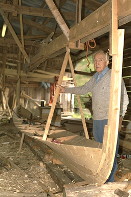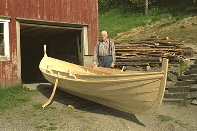

(Pictures: Olaf Mølslett and late Johan Hårstad are both wellknown boat builders of the Åfjord boat)


(Pictures: Olaf Mølslett and late Johan
Hårstad are both wellknown boat builders of the Åfjord boat)
The Åfjord boat has a long tradition. In fact, historian`s trace
the lines and shapes of this fast sailing boat back to Viking times. In
earlier days about 1000 boats were built per year - a big amount considering
the small population of Åfjord. Farmers living in the three valleys
Nordalen, Stordalen and Sordalen spent months during wintertime constructing
boats in their barns or sheds when there was less work to be done at the
farm. The boats were built in various sizes and sold to local fishermen
as well as to people all over the country. The material used was spruce
cut in the farmer`s woods and split rivets to frame the boat together.
The knowledge of this craftsmen were passed on from father to son. In springtime
the boats were transported down to the fjord using up to nine horses depending
on the size.
At the celebration of the 1000 year anniversary of the discovering
of America in 1986, the boat called The Norseman sailed from Canada via
New York along the Eastern coast down to Florida. There it was given as
a gift from Norway to the American people and exhibited at the Walt Disney
Epcot Center.
During fishing seasons, the fishermen from Åfjord sailed all
the way north to Lofoten to participate in the famous cod fishing in March.
The trip could take weeks depending on weather conditions. Other fishing
seasons were in January - February for herring fishing at places along
the coast.
Andreas Rachløw (born 1921) participated in the Lofoten fishing
from 1937: ..We lived in the boat during the fishing periods. Just headed
for a harbour and stayed in small shacks. There were hundreds of boats
and competitions among them to get to the right fishing spots at the right
time. In 1896 history books tells that 32,000 fishermen joined the fishing
in Lofoten. Fishing tackle used were long line, nets, etc. Around 1920
boats with engines entered the area and soon replaced the sailing boats.
The fishermen sold the fish to buyers coming to the fishing resorts during
the fishing season. Boats usually returned from Lofoten with boats full
of fish just before Easter. After returning back home the salted fish was
further prepared for clipfish. People stood out in the water by the shore
washing the cod with wooden mittens on their hands. Others took it further
up on the rocks using wheelbarrows. There the fish was salted and stacked
in piles. Later the fish was dried on the slopes of bare rock for about
six to eight weeks. If there was rainy weather or too warm and sunny, the
fish had to be put up in neat stacks with sheltering from weather. Several
other preparations were done for the fish to look as delightful as possible
and with best possible quality. Women and children took part in this work
- people from inland valleys came to help to earn money when the boats
returned from the faraway fishings places. The boats then took the fish
further south to the town of Kristiansund N. for sale..
![]()
Back to Main Page